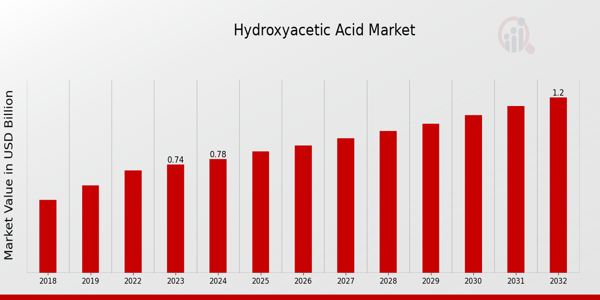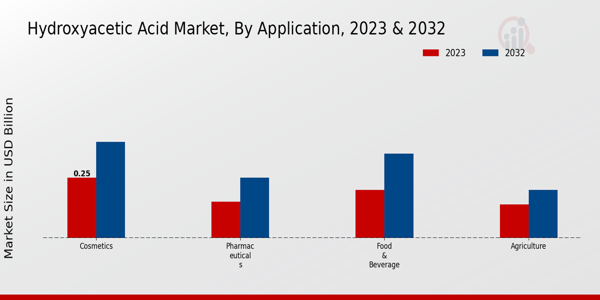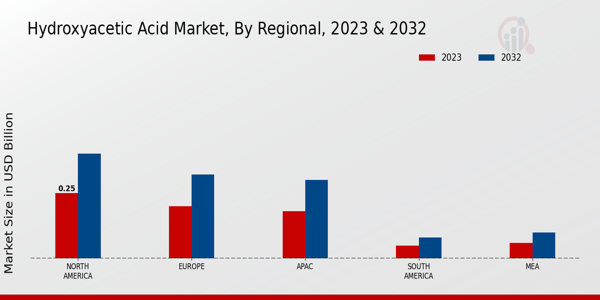Global Hydroxyacetic Acid Market Overview
The hydroxyacetic acid market size was estimated at 0.82(USD billion) in 2024. The hydroxyacetic acid market is expected to grow from 0.87(USD billion) in 2025 to 1.4(USD billion) by 2034. The hydroxyacetic acid market CAGR (growth rate) is expected to be around 5.50% during the forecast period (2025 - 2034).
Key Hydroxyacetic Acid Market Trends Highlighted
The Hydroxyacetic Acid Market is experiencing notable growth driven by increasing demand in various industries, particularly in cosmetics and personal care products. Its ability to act as an exfoliating agent and its effectiveness in skin-care formulations have positioned it as a preferred ingredient.
The rise in consumer awareness about skin health and wellness is further fueling market expansion. Additionally, the food and beverage sector utilize hydroxyacetic acid as a food preservative and flavoring agent, promoting its versatility.
These factors collectively contribute to a favorable environment for market growth. Opportunities to be explored in the hydroxyacetic acid market include the expansion of applications beyond traditional sectors.
The pharmaceutical industry, particularly in drug development and formulation, presents significant potential for hydroxyacetic acid. Furthermore, as natural and organic products gain traction, manufacturers might consider using bio-based hydroxyacetic acid derived from sustainable sources.
This aligns with growing consumer preferences for environmentally friendly and sustainable solutions. Recent trends indicate a shift towards formulations that highlight natural ingredients, prompting companies to innovate and enhance their product offerings.
There is an observed increase in research and development aimed at improving the efficacy and sustainability of hydroxyacetic acid. Additionally, collaborations between key players in various sectors are emerging, enhancing distribution networks and expanding market presence.
Overall, the hydroxyacetic acid market is poised for growth, supported by evolving consumer preferences and expanding applications across multiple industries. The focus on sustainability and natural products will shape the future landscape, presenting both challenges and opportunities for stakeholders in the market.

Source: Primary Research, Secondary Research, MRFR Database and Analyst Review
Hydroxyacetic Acid Market Drivers
Growing Demand for Natural and Organic Products
The increasing shift towards natural and organic products is a significant driver for the Hydroxyacetic Acid Market. Consumers are becoming more conscious of the ingredients used in their personal care products and food items.
Hydroxyacetic acid, also known as glycolic acid, is derived from natural sources like sugarcane and is favored for its exfoliating properties. This trend has fostered a surge in the production and use of products that contain hydroxyacetic acid, particularly in cosmetics and skincare.
Companies are committed to developing formulations that are both effective and promote a clean label, leading to greater adoption of hydroxyacetic acid in various applications. This growth in consumer awareness has prompted manufacturers to innovate and create more eco-friendly products, aligning with the demand for sustainability.
Moreover, the beauty and personal care industry is consistently evolving, where natural ingredients are sought after for their health benefits, which further enhances the potential for hydroxyacetic acid in the market.
As consumers gravitate towards ingredients that they perceive as safer and gentler, businesses are likely to respond to this demand, leading to an accelerated growth rate for the Hydroxyacetic Acid Market.
Increasing Applications in the Pharmaceutical Industry
The Hydroxyacetic Acid Market is witnessing a rise in demand from the pharmaceutical sector as hydroxyacetic acid is recognized for its therapeutic properties. This compound is utilized in various formulations, including skin creams and topical treatments for conditions such as acne and psoriasis.
The pharmaceutical industry continues to invest in research and development to explore new applications for hydroxyacetic acid, thus driving market growth. Additionally, the increasing incidence of skin-related disorders adds to the demand for effective treatment options containing hydroxyacetic acid.
Rising Awareness of Skin Care Benefits
The awareness among consumers regarding the benefits of hydroxyacetic acid for skin care is significantly driving the Hydroxyacetic Acid Market.
Many consumers are turning to products containing glycolic acid for its proven ability to promote skin renewal, enhance texture, and reduce the appearance of aging. As skincare routines become more prevalent and consumers seek products that deliver visible results, the demand for hydroxyacetic acid in cosmetic formulations continues to rise.
Hydroxyacetic Acid Market Segment Insights:
Hydroxyacetic Acid Market Application Insights
The Hydroxyacetic Acid Market revenue is experiencing notable growth, particularly within the application segment. The market reflects a diverse range of applications, with key sectors including cosmetics, pharmaceuticals, food, beverage, and agriculture, each contributing to the industry's overall landscape.
The cosmetics application had a significant share, valued at 0.25 USD billion in 2023 and growing to 0.4 USD billion in 2032, driven by increasing consumer awareness of skin care products and the demand for chemical exfoliants. This segment held the majority due to the effectiveness of hydroxyacetic acid as an ingredient in various formulations, offering aesthetic and functional benefits.
In the pharmaceuticals sector, hydroxyacetic acid was valued at 0.15 USD billion in 2023, expected to expand to 0.25 USD billion by 2032, influenced by its use in drug formulations and potential therapeutic applications, further showcasing its significance in modern medicine.
The food beverage industry, while smaller, also demonstrated potential, starting at 0.2 USD billion in 2023 and estimated at 0.35 USD billion in 2032, attributed to its applications as a food preservative and acidity regulator.
The agriculture segment, valued at 0.14 USD billion in 2023 and projected to grow to 0.2 USD billion by 2032, played a critical role in crop enhancement and organic farming, tapping into the growing trend of sustainable agricultural practices.
The overall Hydroxyacetic Acid Market statistics reflect a balanced growth trajectory in these applications, with each contributing uniquely based on consumer demands and industry trends, creating numerous opportunities for future expansion.
The increasing emphasis on personal care, healthcare innovations, sustainable solutions in food production, and enhancement in agricultural practices collectively drive market growth, addressing both consumer needs and regulatory demands across these sectors.
The impurities and challenges faced in sourcing and processing may pose hurdles, yet they also present opportunities for innovation and improvement in production techniques, further shaping the dynamics of the Hydroxyacetic Acid Market.

Source: Primary Research, Secondary Research, MRFR Database and Analyst Review
Hydroxyacetic Acid Market End Use Insights
The Hydroxyacetic Acid Market is poised for growth, particularly within the end use segment, which encompasses personal care products, industrial chemicals, and food preservatives.
Personal care products, such as skincare and cosmetics, represent a significant portion of the market due to the increasing demand for natural and effective formulations that utilize hydroxyacetic acid for exfoliation and skin health. Meanwhile, industrial chemicals offer substantial application potential, as hydroxyacetic acid is employed in manufacturing and chemical processes.
The food preservatives category plays a crucial role as well, with the compound serving as a safe and efficient option for enhancing food quality and shelf life. This diverse range of applications highlights the versatility and significance of hydroxyacetic acid, positioning it favorably for continuous market growth driven by consumer preferences for sustainable and quality-centered products.
Overall, the Hydroxyacetic Acid Market is experiencing upward momentum as it adapts to evolving demands spanning multiple sectors.
Hydroxyacetic Acid Market Formulation Insights
The Hydroxyacetic Acid Market, particularly in the formulation segment, has shown robust growth dynamics. The diverse applications in industries such as cosmetics, pharmaceuticals, and food products largely drive this growth.
Within this segment, the formulations can be categorized into liquid, powder, and gel forms. The liquid formulations hold significant importance due to their widespread usage in skincare products, making them a prominent choice among consumers for their ease of application.
Powder formulations, known for their stability and versatility, have garnered attention as they can be utilized in various applications, particularly in personal care items and dietary supplements. Gel formulations are also crucial as they provide user-friendly textures, making them favorable in cosmetic products aimed at moisturizing and anti-aging effects.
The ongoing trend of increasing demand for natural and organic products further enhances the potential for the Hydroxyacetic Acid Market, emphasizing the importance of innovative formulations. Overall, the market's positive growth trajectory is supported by the significant demand and diversification within the formulation segment.
Hydroxyacetic Acid Market Distribution Channel Insights
The distribution channel segment of the Hydroxyacetic Acid Market has shown robust growth dynamics. Online distribution channels have gained traction due to the increasing trend of e-commerce, facilitating easier access to hydroxyacetic acid products for consumers and businesses alike.
In addition, retail sectors continue to play a significant role in the distribution landscape, capitalizing on in-person shopping experiences and providing a direct way for consumers to purchase these products. Meanwhile, wholesale remains a cornerstone of market growth, enabling bulk transactions that cater to manufacturers and large enterprises, emphasizing cost efficiency.
The interplay among these channels is crucial as it caters to diverse buyer preferences and strengthens market reach, ultimately influencing the Hydroxyacetic Acid Market revenue and its overall growth trajectory. The evolving consumer behaviors and digital transformation in the retail space present ample opportunities for expansion across these distribution avenues.
Hydroxyacetic Acid Market Regional Insights
Within the regional segmentation, North America held a significant position with a valuation of 0.25 USD billion in 2023, projected to increase to 0.4 USD billion in 2032, demonstrating a majority share due to its robust industrial applications. Europe followed closely, valued at 0.2 USD billion in 2023 and expected to reach 0.32 USD billion by 2032, driven by rising demand in cosmetic and pharmaceutical industries.
The APAC region, valued at 0.18 USD billion in 2023, is also poised for growth, increasing to 0.3 USD billion by 2032, indicating a rising consumption trend in emerging markets. Meanwhile, South America started at a smaller valuation of 0.05 USD billion in 2023 and increases to 0.08 USD billion by 2032, reflecting limited but steady growth in agricultural applications.
Lastly, the MEA region observed a valuation of 0.06 USD billion in 2023, projected to grow to 0.1 USD billion by 2032, suggesting gradual development in industrial uses. Overall, the regional segmentation showcases diverse growth opportunities across various markets, with North America and Europe being the most dominant players.

Source: Primary Research, Secondary Research, MRFR Database and Analyst Review
Hydroxyacetic Acid Market Key Players and Competitive Insights:
The Hydroxyacetic Acid Market is increasingly competitive as various players strive to enhance their market share through innovations, strategic partnerships, and efficient supply chain management.
With the rising demand for hydroxyacetic acid across diverse applications such as personal care, pharmaceuticals, and textile industries, manufacturers are adopting advanced technologies for production and formulation.
The market dynamics are influenced by factors like regulatory frameworks, consumer preferences, and environmental considerations. As more companies enter this sector, the competitive landscape is characterized by the continuous introduction of improved and sustainable product offerings.
Understanding the strengths and capabilities of key market players is essential for recognizing trends and opportunities within the hydroxyacetic acid market. Nouryon has established a significant presence in the Hydroxyacetic Acid Market through its commitment to innovation and sustainability.
The company harnesses advanced manufacturing processes to produce high-quality hydroxyacetic acid that meets stringent industry standards. Nouryon's extensive knowledge in technology and chemistry enables it to create customized solutions tailored to the specific needs of various sectors, enhancing its reputation among customers.
Its focus on research and development not only facilitates the introduction of new products but also improves the performance of existing offerings. Moreover, Nouryon's dedication to sustainable practices positions it favorably as the demand for eco-friendly and safe chemicals grows.
The company's strong supply chain and customer service further reinforce its competitive edge, ensuring that it meets clients' diverse requirements effectively. Solvay is a prominent player in the Hydroxyacetic Acid Market, celebrated for its innovative solutions and broad application potential.
The company leverages its robust research and development capabilities to advance hydroxyacetic acid technologies, allowing it to maintain a competitive edge. With a focus on sustainable chemistry, Solvay emphasizes environmentally friendly production methods and sustainable product development that resonate well with modern consumer trends toward sustainability.
Solvay's strategic investments in innovation not only drive efficiency but also foster customer loyalty, as they produce high-purity hydroxyacetic acid for various applications, including healthcare and cosmetics. The company's global reach and extensive network enhance its market presence, facilitating efficient distribution and consistent product supply across different geographical regions.
Solvay's robust engagement with stakeholders helps to strengthen its market position and expand its influence within the hydroxyacetic acid segment.
Key Companies in the hydroxyacetic acid market Include:
Hydroxyacetic Acid Market Developments
Recent developments in the Hydroxyacetic Acid Market highlight significant activities among major companies such as Nouryon, Solvay, Lanxess AG, and BASF. Market growth is driven by increasing demand across industries, notably in cosmetics and personal care products, where hydroxyacetic acid is used for its exfoliating properties.
This heightened interest from sectors emphasizing sustainable and biodegradable products is boosting valuations and investment in research and development. Notably, significant acquisitions and mergers are influencing dynamics in the market, with companies exploring strategic partnerships to enhance their product offerings and market reach.
For example, some firms are pursuing vertical integration strategies that can streamline production processes and reduce costs. Additionally, competitive pressures are prompting companies like Eastman Chemical Company and Huntsman Corporation to innovate and expand their hydroxyacetic acid portfolios to meet evolving consumer preferences.
The current trend indicates a consolidation of resources among industry leaders, aiming to capture larger market shares amidst growing environmental regulations and a shift towards greener chemicals. Overall, the Hydroxyacetic Acid Market is experiencing vigorous developments, with various companies actively positioning themselves to leverage these market opportunities.
Hydroxyacetic Acid Market Segmentation Insights
| Report Attribute/Metric |
Details |
| Market Size 2024 |
0.82 (USD billion) |
| Market Size 2025 |
0.87(USD billion) |
| Market Size 2034 |
1.4(USD billion) |
| Compound Annual Growth Rate (CAGR) |
5.50% (2025 - 2034) |
| Report Coverage |
Revenue Forecast, Competitive Landscape, Growth Factors, and Trends |
| Base Year |
2024 |
| Market Forecast Period |
2025 - 2034 |
| Historical Data |
2020 - 2024 |
| Market Forecast Units |
USD billion |
| Key Companies Profiled |
Nouryon, Solvay, Lanxess AG, Kemira, Hawkins, Inc., Ashland Global Holdings, Cargill, Huntsman Corporation, The Dow Chemical Company, BASF, Clariant AG, Sierra International, Mitsubishi Chemical Corporation, SABIC, Eastman Chemical Company |
| Segments Covered |
Application, End Use, Formulation, Distribution Channel, Regional |
| Key Market Opportunities |
Rising demand in cosmetics industry, Growth in biodegradable plastics, Increasing popularity in food applications, Expansion in pharmaceutical formulations, Advancements in biotechnology processes |
| Key Market Dynamics |
increasing cosmetic demand, expanding pharmaceutical applications, growing food industry needs, stringent regulatory compliance, and raising awareness of skincare benefits |
| Countries Covered |
North America, Europe, APAC, South America, MEA |
Frequently Asked Questions (FAQ) :
The Hydroxyacetic Acid Market is expected to be valued at 1.4 USD billion by 2034.
The projected CAGR for the Hydroxyacetic Acid Market from 2025 to 2034 is 5.50%.
North America is expected to hold the largest market share, valued at 0.4 USD billion by 2032.
The Cosmetics application segment shows significant growth, increasing from 0.25 USD billion in 2023 to 0.4 USD billion by 2032.
Key players in the market include Nouryon, Solvay, Lanxess AG, and BASF.
The Pharmaceuticals application segment is expected to reach a market value of 0.25 USD billion by 2032.
The Food Beverage application segment is projected to be valued at 0.35 USD billion by 2032.
The APAC region is projected to reach a market value of 0.3 USD billion by 2032.
The Agriculture application segment is expected to be valued at 0.2 USD billion by 2032.
The market size for South America is expected to increase from 0.05 USD billion in 2023 to 0.08 USD billion by 2032.

















